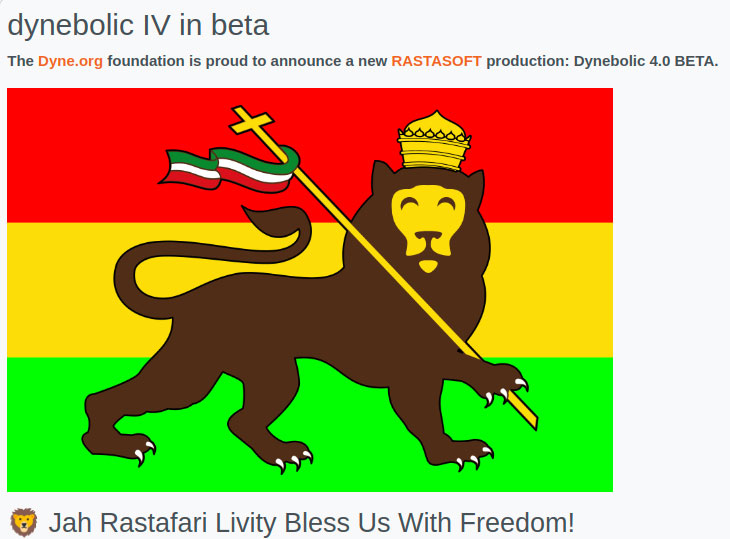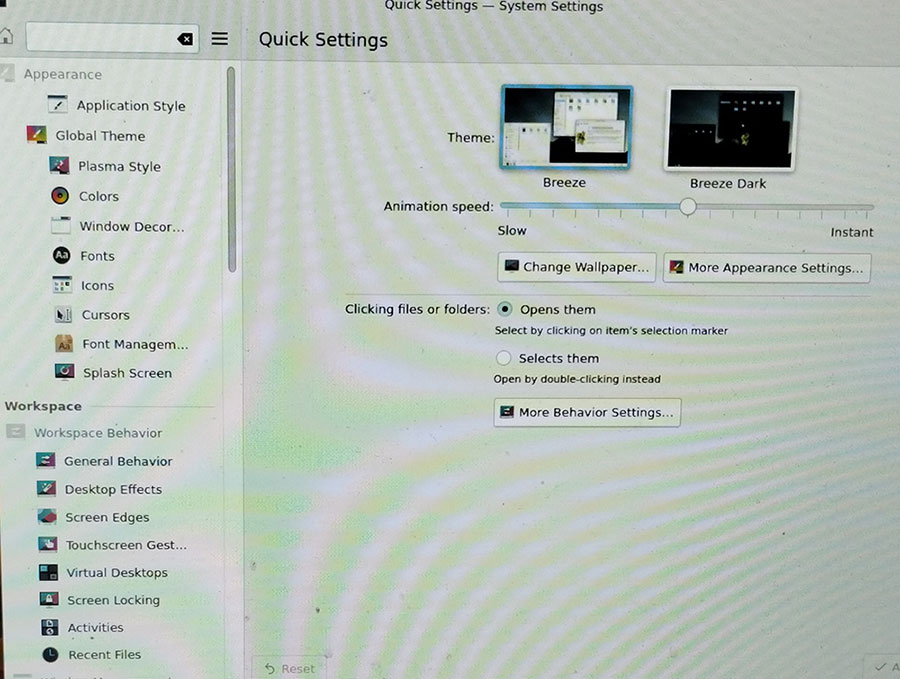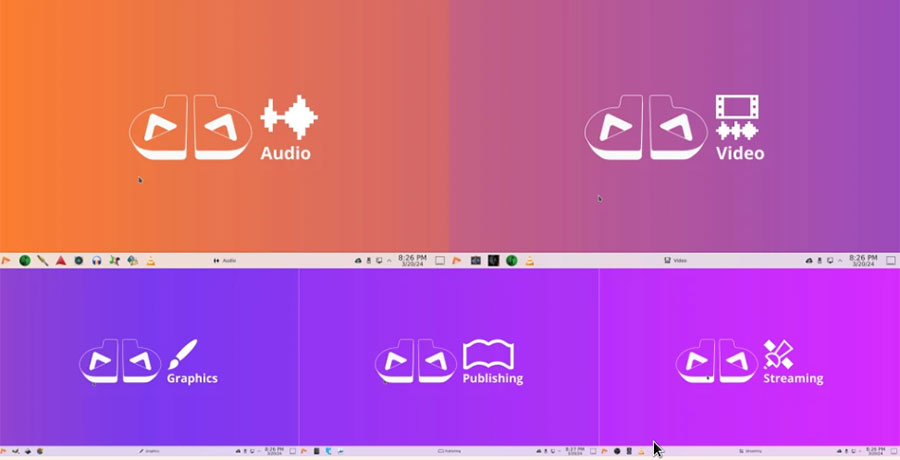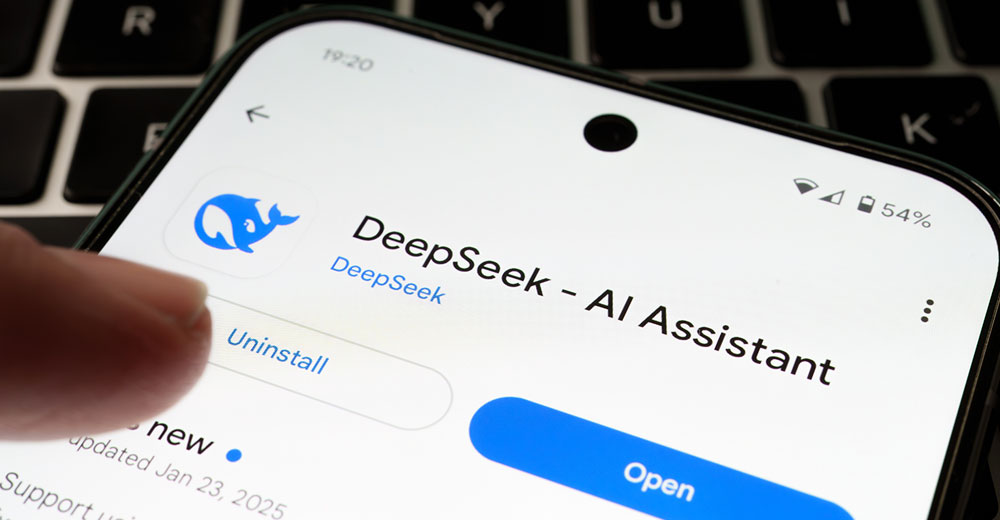The beta 4.0 release of Dynebolic Linux announced innovations for creatives looking for a self-contained production and publishing tool. If you are unfamiliar with distributions built on the KDE desktop and others, you could easily be misled about its innovations.
The latest beta release includes little to make Dynebolic stand out as a unique operating system that captures the needs of graphic artists, writers, publishers, and others. The most significant detail is that this beta 4.0 edition is the first to carry the slightly rebranded Dynebolic Linux moniker in a decade. Earlier releases were called Dyne:bolic.
However, that does not mean it lacks the potential to become a great platform for creatives in future releases. So far, though, Dynebolic Linux is big on hype and short on delivery.

The left side panel of Dynebolic is a modified replay of the KDE desktop’s activities feature that also duplicates the virtual workspaces feature common in many Linux distros.
The announcement hype caught my attention, as I was hoping for a newly created Linux OS with offerings to feed my passion for Linux and appetite for innovative, creative tools.
After perusing the developer’s website and testing the beta release, I was disappointed. Not because the beta’s performance let me down — the release is functional but clearly a work in progress. It has too many user limitations and missing elements. Aside from a desktop design tweak, I found nothing in Dynebolic compared to other distributions.
Confusing Lineage Creates Poor Impression
According to the mid-March release notice, the Dyne.org foundation announced a new Rastasoft production: Dynebolic 4.0 Beta. Rastasoft was — and maybe still is — a website design and development company based in Tehran, Iran.

The developer’s website describes Dyne.org as a digital community and free software foundry that shares tools, practices, and narratives to empower artists, creatives, and citizens in the digital age. It claims to be focused on providing technology that people can understand and control rather than having people controlled by entities.
The relationship between Rastasoft and Dyne.org is unclear. Both websites refer to the same goals including adhering to unadulterated open source by not using any licensed proprietary code. It is also unclear whether Rastasoft or the Dyne organization is the current and/or original developer.
This updated beta release attempts to reintroduce people to the free software movement and its original values. According to the release notes and website posts, Rastasoft hopes to attract its software community volunteers to improve its development capabilities.
Common Bond Built Around Freedom Expectations
I initially found both websites a bit of a distraction with hawking the merits of Dynebolic Linux with references to the Jah Rastafari movement. The connection to a potential choice of operating systems seems to be an unnecessary misdirection.
As Britannica.com explains, followers known as Rastafarians believe they are being tested by Jah (God) through slavery and the existence of economic injustice and racial “downpression” (not oppression).
That religious and political movement began in Jamaica in the 1930s with a hope for repatriation to Africa. Somewhere along the way, the new Linux distro’s stand on supporting free software to aid creatives emerged.
Dyne:bolic Linux (as its original branding) first appeared on March 15, 2005, and has been dormant for the last 10 years after the release of version 3. Some sources say the initial beta 4 release happened in September 2021. So the March release announcement of beta 4 might well be an updated re-release.
The distro progressed through earlier versions based on Gnome 2 and Xfce desktop environments. The current beta 4 version is an upgrade to a modified KDE Plasma 5 desktop based on the Devuan 5 “Daedalus” fork of Debian. The major difference is that Devuan uses sysvinit instead of init.d, which allows users to control system startup processes, services, daemons, and threads.
More Features Could Be Coming
Part of my displeasure with the current beta 4 release is what was not included compared to what was promised. Both Dyne.org and Rastasoft developed a collective toolbox for hackers, makers, and dreamers.
The application descriptions sound intriguing and would be handy tools for tasks specialized creative users could devour. But none of these tools is included in the Dynebolic release — at least not yet. Access to this specialized software would distinguish this distro from other Linux OSes.
A key driver for Linux desktop adoption is providing unique distros that meet the needs of specialized user interests. Saying that Dynebolic Linux caters to creatives without including anything leaves potential users with no reason to adopt a reintroduced product.
Limited Functionality a Bummer
Beta 4’s ISO is a live image only. You can burn the ISO to a USB drive instead of a DVD. However, that added portability has little value because productivity is limited to the basic software bundled in the release.
A live image only means you can boot the OS on supported computers without changing anything on the hard drive. In this case, the live image cannot be installed for permanent use. It also lacks package management tools.
That means you cannot add or remove software. If that design continues in upcoming editions, users will be stuck with an operating system that they cannot update.
Another consideration is the number of additional applications developers can cram into future live session-only ISOs. DVDs — and to some extent, the installation capacity of USBs burned from an ISO image — max out. The usual workaround is installing a base OS and then using package management tools to download and save more software to the hard drive.
Frustrating Hands-on Testing
I could not take screenshots of Dynebolic without resorting to an external camera. No screen grab applications were in the menu.
Creatives working in multimedia have the best chance of finding standard Linux applications. Numerous options are available in the multimedia and graphics menus. However, only the KDE web browser Konqueror, two KDE-based text editors, and Vim were provided.
So, as a creative, I had no fully functional word processing tools and could not create spreadsheets or other presentation slides due to a lack of office applications. Nor could I print out anything, as no printer support exists.

Dynebolic uses the style of KDE’s application and Quick Settings menus, but nearly every category lacked a full offering of setting options.
I tested Dynebolic on a laptop connected to a large-screen secondary display. While booting, all of the startup processes filled the large screen. But once the boot completed, the desktop and open windows only displayed on the smaller laptop screen.
No settings existed to configure secondary monitors. Adding insult to injury, though, when I opened the Activities panel, it would only display on the secondary monitor.
Taking a Quick Tour
One of the key KDE redesigns, as the developer describes it, gives users a new experience organized as different journeys into creativity called workflows. It is a rebranding of KDE’s classic Activities feature.

Dynebolic’s desktop provides five pre-sets for specific workflows: streaming, audio, video, graphics, and publishing. You reach each one from the desktop panel or keyboard shortcuts. The workflow concept duplicates Plasma’s Activities, which is simply a collection of virtual workplaces into which you can load specific applications used for each workflow or creative specialty.
When multiple tasks and windows are loaded, you do not have to minimize windows or navigate around a collection of unrelated screens. Instead, you simply switch to your desired virtual workflow space. You can customize workflows in the system settings.
One of the unresolved issues with the KDE Plasma 5 desktop is the near duplicity in the two similar functions — the Activities (or, in this case, the Workflow views) and the virtual desktops that function separately. In this beta 4 release, when I disconnected the second monitor so it was not always visible, I could not access the Activities/Workflow views when I added two or more virtual desktops.
Bottom Line
With the target audience being creatives working with streaming, audio, video, graphics, and publishing applications, Dynebolic needs to provide a more focused desktop platform. The beta 4 version is little more than a remake of other KDE-based distros. As such, it serves no specialized purpose.
Until that happens, Dynebolic will remain an unfinished OS with little genuine usefulness to creatives or anyone else.
Suggest a Review
Is there a Linux software application or distro you’d like to suggest for review? Something you love or would like to get to know?
Email your ideas to me, and I’ll consider them for a future column.
And use the Reader Comments feature below to provide your input!























































